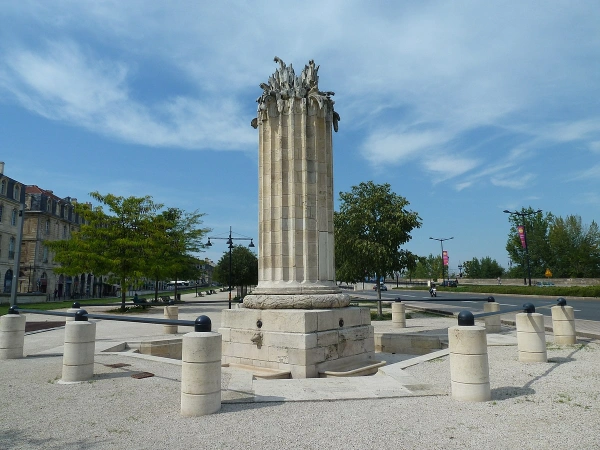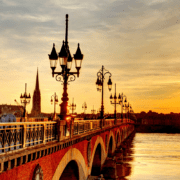
Fontaine de la Grave: history and charm in Bordeaux
The Fontaine de la Grave in Bordeaux is a historical monument built in 1788 by Richard-François Bonfin. It symbolizes the spring of water, distributed through four mascarons that flow into vases.
Today, the Fontaine de la Grave is a highlight in Bordeaux, surrounded by landmarks such as the Basilica of St. Michael, the Stone Bridge and the Porte de la Monnaie. All these places can be visited with the free tours of Bordeaux.
History of the Fontaine de la Grave in Bordeaux
The Fontaine de la Grave in Bordeaux is a historic monument with a fascinating history. Below, we will explore its origin and construction, its rehabilitation and relocation, as well as its historical importance in Bordeaux.
Origin and construction of the source
La Fontaine de la Grave was built in 1788 by Richard-François Bonfin. Its charming and unique design has left a lasting mark on the history of Bordeaux. This emblematic fountain was originally supplied by the fountain of l’Or.
Rehabilitation and relocation of the fountain
In 1735, the fountain was restored by Etienne Dardan and François Bonfin, and became an important source of water for the citizens and sailors of the Port de la Lune in Bordeaux. However, in 1788, the jurade commissioned Richard-François Bonfin to rebuild the fountain of the Grave. This reconstruction involved moving the fountain to the north to place it in front of the Place de la Grave.
Historical importance of the fountain in Bordeaux
The Fontaine de la Grave has played a significant role in the history of Bordeaux. Before the construction of the Pierre bridge in 1819, this fountain was a vital source of water for the citizens and sailors in the port of La Lune. Its presence in the city has become a symbol of the importance of water and its equitable distribution to the community.
Characteristics and symbolism of the Fontaine de la Grave
The Fontaine de la Grave in Bordeaux is an architectural work of great beauty and uniqueness. Its main characteristics and symbolism are described below:
Architectural description of the fountain
The Fontaine de la Grave is distinguished by its elegant and meticulous design. Built in 1788, it consists of four mascarons pouring water into vessels, representing the spring from which it springs. Its ornamental details and neoclassical architecture make it a distinctive feature of the Bordeaux cityscape.
The fountain was restored in 1735 and then moved north to face the Place de la Grave. Before the construction of the Pierre bridge in 1819, the Fontaine de la Grave was a vital source of water for the citizens and sailors of the Port de la Lune, providing them with water.
Symbolic representations in the Fontaine de la Grave
La Fontaine de la Grave stands out not only for its aesthetics, but also for the symbolism it conveys. The presence of constantly moving water symbolises the life and vitality of the city.
The masks adorning the fountain also represent the connection between nature and civilisation, reminding us of the importance of water as a source of life and an indispensable resource for the community.
This historic fountain is a place of encounter and convergence, where residents and visitors can enjoy its architectural beauty and reflect on the importance of water in daily life and in the development of the city.
Landmarks near the Fontaine de la Grave
La Fontaine de la Grave is surrounded by several emblematic sites, which can be visited and toured from Bordeaux.
These places offer a unique blend of history, architecture and charm, complementing the Fontaine de la Grave experience. Here are just a few of them:
St Michael’s Basilica
The Basilica of St Michael, located near the Fontaine de la Grave, is an architectural jewel in the Gothic style. Built in the 14th century, this impressive church is notable for its imposing bell tower and exquisite stained glass windows. Its interior houses works of religious art and offers an atmosphere of serenity for those who visit.
Stone Bridge
The Stone Bridge, also known as the Pont de Pierre, is an iconic arched bridge built in the 19th century. It connects the banks of the Garonne River and offers spectacular views of the city. Strolling across this historic bridge is a perfect opportunity to admire Bordeaux’s cityscape and capture breathtaking photographs.
Porte de la Monnaie
The Porte de la Monnaie is an ancient city gate dating from the 18th century. This imposing stone structure used to be one of the main entrances to Bordeaux. Today, it is a historical landmark and an impressive example of the architecture of the time. Strolling around the Porte de la Monnaie allows you to immerse yourself in the rich history of the city.
Other places of interest in Bordeaux
Apart from the impressive Fontaine de la Grave, the city of Bordeaux has many emblematic sites worth visiting. Here are just a few of them:
Château Pape Clément
Located in the heart of the Pessac-Léognan vineyards, Château Pape Clément is a historic château dating back to the 13th century. It was founded by Bertrand de Goth, who later became Pope Clement V. The château has stunning gardens and offers guided tours that allow you to explore its history and enjoy wine tastings.
Bassins de Lumières
The Bassins de Lumières is a unique experience that combines art and technology. Located in a former submarine base on the quays of Bordeaux, this immersive space projects works of art onto the walls, ceilings and floors of the vast spaces, creating a fascinating visual and sensory experience.
Place de la Bourse
The Place de la Bourse is one of the most emblematic squares in Bordeaux. Designed in the 18th century, it is notable for its neoclassical architecture and features the famous Fountain of the Three Graces in its centre. The square offers amazing views of the Garonne River and is an ideal place to stroll around and enjoy the atmosphere of the city.
If you’re looking for places to eat in Bordeaux, we recommend you check out our post and enjoy your visit by sampling the French gastronomy that Bordeaux has to offer.



